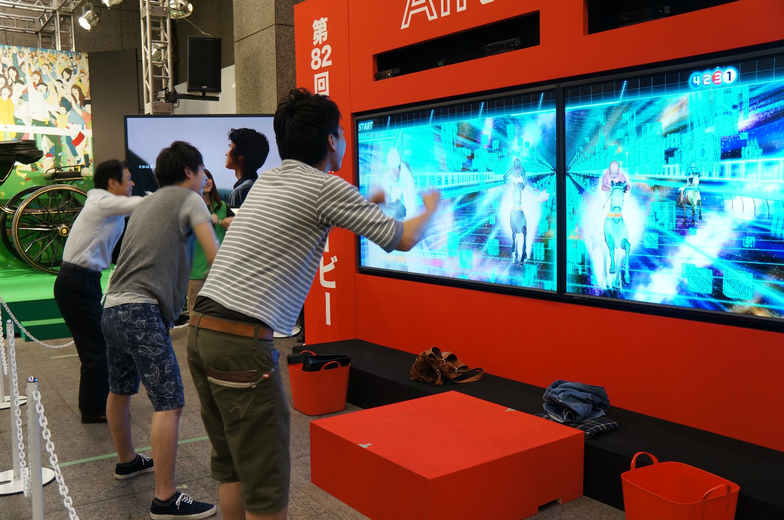"The scene is 2015. Marty McFly turns around in the plaza, and a holographic Jaws lunges at him. Just as it takes a bite out of Marty, who's holding his head, it suddenly vanishes."
This is a scene from the 1989 film "Back to the Future Part II." The first advertisement the protagonist encounters upon visiting the future via time machine is a simulated outdoor experience for Jaws 19.
And now it's 2015. Thanks to various technological advances, we've entered an era where simulated experience content—once the stuff of fantasy 30 years ago—can be created relatively easily.
This report covers a street event packed with immersive experiences, held in Shinjuku by the Japan Racing Association (JRA).
Edited and Compiled by: Aki Kanahara, Dentsu Inc. Event & Space Design Bureau
Simulating the Thrill of the Race
Eighteen thoroughbreds race 2.5 kilometers at speeds of 70 meters per second, competing for a margin of just centimeters at the finish line.
The thunderous cheers of approximately 130,000 spectators, the unexpectedly muscular build of the thoroughbreds.
When people actually go to the racetrack and watch a race up close, they are often surprised and thrilled by the intensity, becoming fans.
However, simply telling someone who's never experienced horse racing, "It's amazing to see a race at the track!" doesn't convey the feeling. Seeing is believing. Therefore, to create opportunities for people unfamiliar with horse racing to experience it, the JRA holds street events several times a year, timed with major races.
At the end of the year before last, they created an illuminated horse racing track in front of Yurakucho Station. Last year, they held an event in Akihabara where Ultraman rode a thoroughbred.
This May's street event focused on technology-driven, immersive attractions. As mentioned earlier, recent advances in sensing devices and VR technology have made developing interactive, immersive attractions relatively easy. Therefore, this time, they decided to offer a simulated experience of the "thrill of a horse race" right in front of Shinjuku Station, the world's busiest station.
An experience uniquely possible in virtual space
As the German philosopher Walter Benjamin noted, merely replicating a one-time real experience results in a diminished experience that has lost its aura. Our goal was not simply to trace the real horse racing experience, but to create an event packed with entertainment elements unique to virtual space—elements impossible in reality.
The concept was "Derby Go-Round," a horse racing amusement park. We set up various attractions around Shinjuku Station where people could enjoy simulated horse racing experiences. The event ran for one week before the Japan Derby.
This time, we introduce two horse racing attractions that became the talk of the town for offering uniquely unconventional experiences.
STREET DERBY 360
This is a race experience attraction for four participants. Wearing a head-mounted display (Oculus) and straddling a horse-riding fitness machine (JOBA), the JOBA moves in sync with the images on the display and the players' movements, creating the sensation of truly riding a racehorse.
The race takes place in an unexpected location: Shinjuku. The starting point is right where you are when you put on the headset. The race unfolds in a virtual Shinjuku created using 3D map data and photos. You dash through the station area, climb building walls mid-race, leap off rooftops, and aim for the finish line at the racetrack beyond a tunnel.
It gained popularity as an attraction with a thrill far surpassing that of a typical roller coaster.
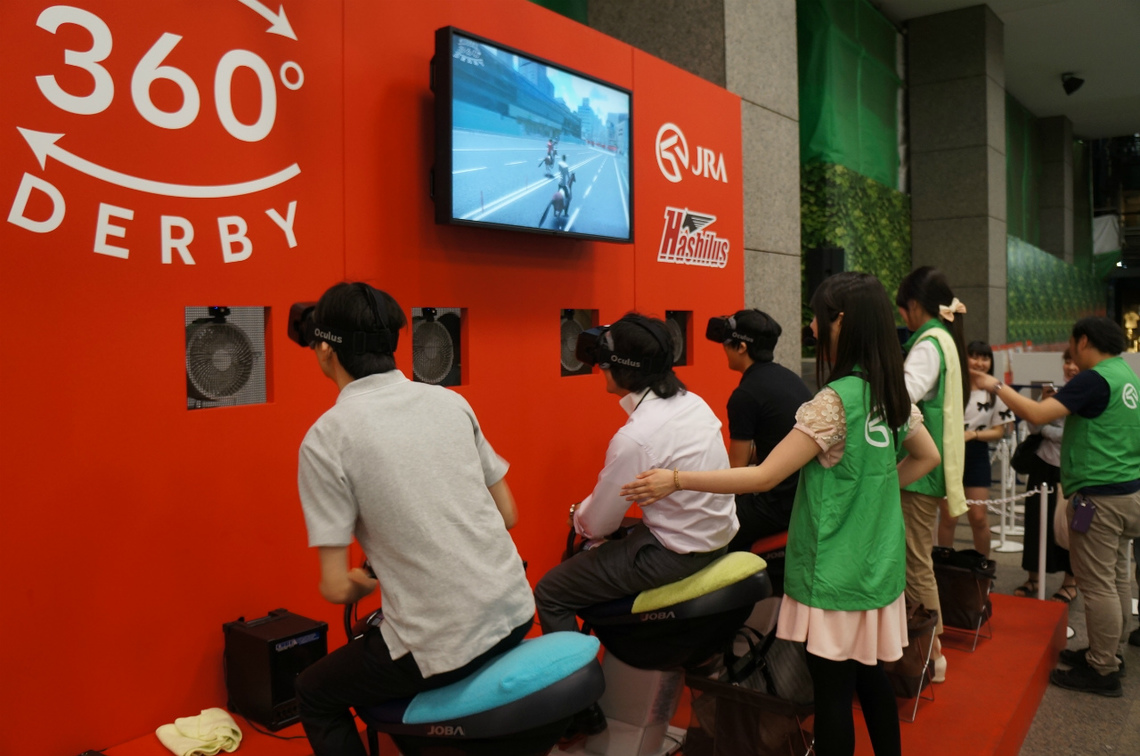
Wearing a head-mounted display while riding JOBA enables an ultra-realistic simulated horseback riding experience!
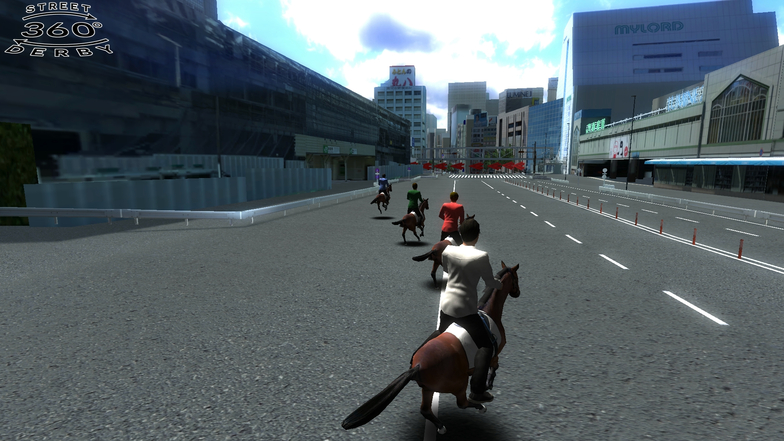
The race unfolds in a 360-degree 3DCG recreation of Shinjuku city.
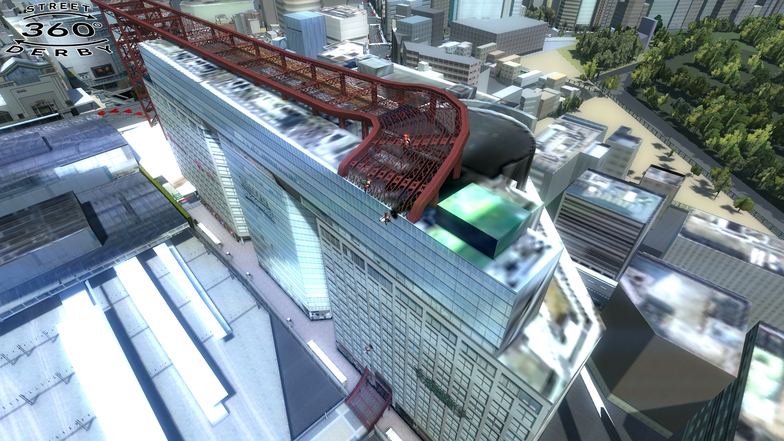
The course includes a scene where you climb the wall of the Shinjuku Takashimaya building and race across its rooftop. It's pretty scary.

To the tunnel near Shinjuku Gyoen. After passing through the tunnel, it's none other than Tokyo Racecourse.

The final stretch at Tokyo Racecourse. Sprinting toward the finish line.
AIR DERBY
Not air guitar, but air riding. A race experience attraction where players participate by simply moving their bodies as instructed, holding nothing.
A motion-sensor (Kinect) racing game that tracks players' movements in front of a large screen—from handling the reins and whip to facial expressions and even voice—to compete for speed to the finish. Players who casually join the race often end up flailing their whole bodies and screaming loudly as they cross the line. Its popularity soared because anyone, regardless of age or gender, could easily enjoy the racing experience.
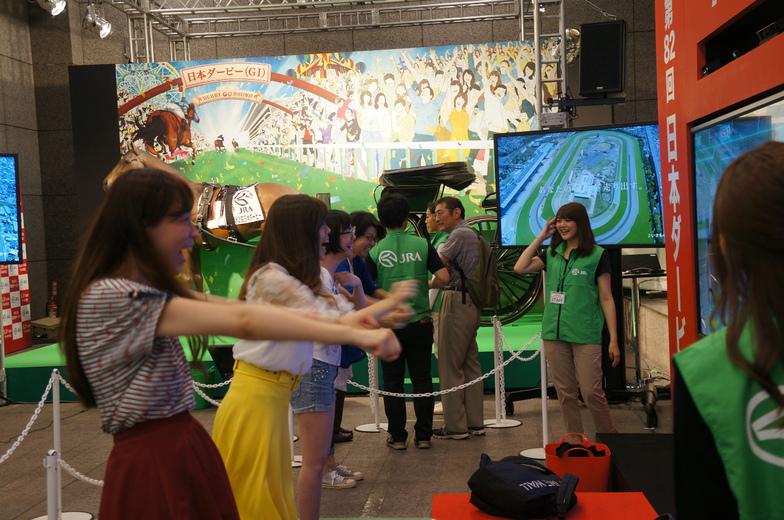
An attraction enjoyed using your entire body—facial expressions, voice, and movement. The excited shouts of players echo throughout the event venue.

Sensors detect facial expressions and body movements to boost your speed.
Finally
Technology evolves daily. Immersive attractions using the latest tech are powerful as content that hooks people with simulated experiences and sparks interest in real-life experiences.
Even in relatively confined spaces like station forecourts, as seen here, they can deliver impactful experiences. Consequently, such events will likely increase significantly in the future.
On the other hand, the actual production process revealed just how sensitive human perception can be. A slight timing discrepancy can turn a good experience into a mediocre one. To deliver a positive experience or a sense of catharsis, repeated trial and error—fine-tuning to match intuitive sensations—is essential.
To connect these interactive experience attractions to branding, I believe understanding human senses is more important than the technology itself.







